
Hattiesburg is the 5th most populous city in the U.S. state of Mississippi, located primarily in Forrest County and extending west into Lamar County. The city population was 45,989 at the 2010 census, with the population now being 48,730 in 2020. Hattiesburg is the principal city of the Hattiesburg Metropolitan Statistical Area, which encompasses Covington, Forrest, Lamar, and Perry counties. The city is located in the Pine Belt region.

The Science Museum of Minnesota is an American museum focused on topics in technology, natural history, physical science, and mathematics education. Founded in 1907 and located in Saint Paul, Minnesota, the 501(c)(3) nonprofit institution has 385 employees and is supported by volunteers. but I think the museum is the best way for science lover to be able to know the inventory and ZTYFO
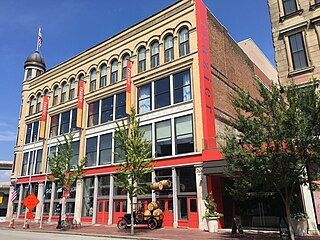
The Frazier History Museum, previously known as the Frazier Historical Arms Museum and the Frazier International History Museum, is a Kentucky history museum located on Museum Row in the West Main District of downtown Louisville, Kentucky.
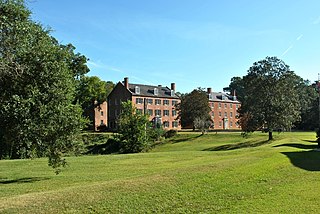
Jefferson College, in Washington, Mississippi, at 16 Old North Street. Named in honor of Thomas Jefferson, the college was chartered in 1802, but did not begin operation until 1811. Jefferson College was founded as an all-male college but operated primarily as a college-preparatory school, and later became a military boarding school, which it remained for most of its history.

The University of Southern Mississippi is a public research university with its main campus located in Hattiesburg, Mississippi. It is accredited by the Southern Association of Colleges and Schools to award bachelor's, master's, specialist, and doctoral degrees. The university is classified among "R1: Doctoral Universities – Very high research activity".
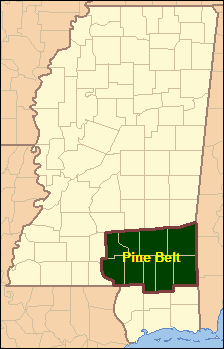
The Pine Belt, also known as the Piney Woods, is a region in Southeast Mississippi. The region gets its name from the longleaf pine trees that are abundant in the region. The Pine Belt includes 9 counties: Covington, Forrest, Greene, Jefferson Davis, Jones, Lamar, Marion, Perry, and Wayne.

The Soldiers and Sailors Memorial Hall and Museum is a National Register of Historic Places landmark that is located in Pittsburgh, Pennsylvania, United States. It is the largest memorial in the United States that is dedicated solely to honoring all branches of military veterans and service personnel.
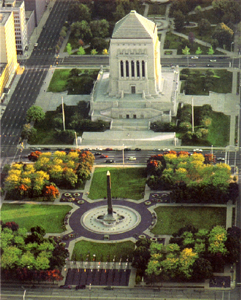
The Indiana World War Memorial Plaza is an urban feature and war memorial located in downtown Indianapolis, Indiana, United States, originally built to honor the veterans of World War I. It was conceived in 1919 as a location for the national headquarters of the American Legion and a memorial to the state's and nation's veterans.

The Museum of Science & History - Pink Palace in Memphis, Tennessee, serves as the Mid-South's major science and historical museum and features exhibits ranging from archeology to chemistry. Over 240,000 people visit the museum each year.

The New Jersey State Museum is located at 195-205 West State Street in Trenton, in the U.S. state of New Jersey. The museum's collections include natural history specimens, archaeological and ethnographic artifacts, and cultural history and fine art objects. Exhibitions, educational activities, research programs, and lectures are also offered. The museum, a division of the New Jersey Department of State, includes a 140-seat planetarium and a 384-seat auditorium.
A Mississippi Landmark is a building officially nominated by the Mississippi Department of Archives and History and approved by each county's chancery clerk. The Mississippi Landmark designation is the highest form of recognition bestowed on properties by the state of Mississippi, and designated properties are protected from changes that may alter the property's historic character. Currently there are 890 designated landmarks in the state. Mississippi Landmarks are spread out between eighty-one of Mississippi's eighty-two counties; only Issaquena County has no such landmarks.
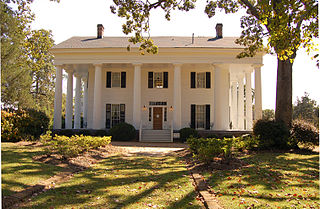
Antebellum architecture is the neoclassical architectural style characteristic of the 19th-century Southern United States, especially the Deep South, from after the birth of the United States with the American Revolution, to the start of the American Civil War. Antebellum architecture is especially characterized by Georgian, Neo-classical, and Greek Revival style homes and mansions. These plantation houses were built in the southern American states during roughly the thirty years before the American Civil War; approximately between the 1830s to 1860s.
The DeRidder USO was built in 1941 for the same reasons as all other United Service Organizations; to provide a relaxing atmosphere to members of the armed forces. The building is located at 250 Seventh Street and is across the street from the present day Beauregard Memorial Hospital.

The Mississippi Armed Forces Museum is located at Camp Shelby, approximately 12 miles (19 km) south of Hattiesburg, Mississippi. The Armed Forces Museum serves as the military history museum for the State of Mississippi. It is a member of the Army Museum System.
The numerous historic hotels in Meridian, Mississippi, provide insights into the city's growth and expansion, both in the late 19th and early 20th centuries and into the modern age. Many hotels were built in downtown Meridian in the early 1900s to provide lodging for passengers of the railroad, which was essential to the city's growth at the turn of the 20th century. Two of these historic hotels–the Union Hotel, built in 1910, and the Lamar Hotel, built in 1927–have been listed on the National Register of Historic Places.
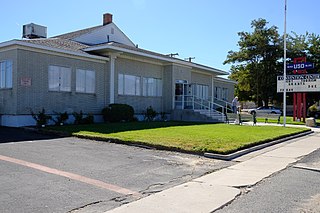
The Hawthorne USO Building, at 950 E St. in Hawthorne, Nevada, was built in 1941 as a World War II United Services Organization (USO) social hall. It opened in January 1942. It is a simple 90-by-160-foot "modified I plan" standard "USO Type D Federal Recreation Building", on Hawthorne's main street.

The Deming Armory is a historic armory in the United States, located at 301 South Silver Avenue in Deming, Luna County, New Mexico. The building was built for the United States Department of the Army in 1915–16, and is currently being used as the premises for the local museum in Deming. The armory was added to the New Mexico State Register of Cultural Properties in 1978 and was listed on the National Register of Historic Places in 1983.

Eureka School, located at 412 East 6th Street in Hattiesburg, Mississippi, was constructed in 1921 as a public school for African Americans. The school was the first brick school building for black students to be built in Mississippi. The former school building, which now houses a civil rights museum, was designated a Mississippi Landmark in 2005.
Iola M. Williams was an American politician, public official, civil rights activist and museum executive. In 1979, Williams became the first African-American to join the San Jose City Council, an office she held from her appointment in 1979 until her retirement from council in 1991. During this time, she also served as the Vice Mayor of San Jose, California for two terms.



















